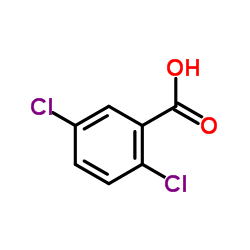2,5-二氯苯甲酸

2,5-二氯苯甲酸结构式

|
常用名 | 2,5-二氯苯甲酸 | 英文名 | 2,5-Dichlorobenzoic acid |
|---|---|---|---|---|
| CAS号 | 50-79-3 | 分子量 | 191.012 | |
| 密度 | 1.5±0.1 g/cm3 | 沸点 | 301.0±22.0 °C at 760 mmHg | |
| 分子式 | C7H4Cl2O2 | 熔点 | 151-154 °C(lit.) | |
| MSDS | 中文版 美版 | 闪点 | 135.8±22.3 °C | |
| 符号 |

GHS07 |
信号词 | Warning |
|
[Oxidative dehalogenation of 2-chloro- and 2,4-dichlorobenzoates by Pseudomonas aeruginosa].
Mikrobiologiia 62(5) , 887-96, (1993) The strain Pseudomonas aeruginosa 142 isolated from the utilising PSBs bacterial association was capable of growth on 2-chloro- and 2,4-dichlorobenzoates as sole carbon sources, but it did not utilize 3-Cl, 4-Cl, 3,5-diCl- and 2,6-dichlorobenzoates. P. aerugi... |
|
|
Degradation of 2,5-dichlorobenzoic acid by Pseudomonas aeruginosa JB2 at low oxygen tensions.
Biodegradation 6(1) , 39-46, (1995) From long-term chemostat experiments, variants of Pseudomonas aeruginosa JB2 were obtained which exhibited altered properties with respect to the metabolism of 2,5-dichlorobenzoic acid (2,5-DBA). Thus, unlike the original strain JB2-WT, strain JB2-var1 is abl... |
|
|
Quantitation in gradient high performance liquid chromatography/inductively coupled mass spectrometry investigated using diclofenac and chlorpromazine.
Rapid Commun. Mass Spectrom. 16(4) , 245-7, (2002) The use of directly coupled high performance liquid chromatography/inductively coupled plasma mass spectroscopy (HPLC/ICPMS) employing chlorine ((35)Cl/(37)Cl) detection has been investigated with respect to the detection and quantitation of the drugs diclofe... |
|
|
Complete genome sequence of the haloaromatic acid-degrading bacterium Achromobacter xylosoxidans A8.
J. Bacteriol. 193(3) , 791-2, (2011) Achromobacter xylosoxidans strain A8 was isolated from soil contaminated with polychlorinated biphenyls. It can use 2-chlorobenzoate and 2,5-dichlorobenzoate as sole sources of carbon and energy. This property makes it a good starting microorganism for furthe... |
|
|
Molecular diversity in the bacterial community and the fluorescent pseudomonads group in natural and chlorobenzoate-stressed peat-forest soil.
Microbiol. Res. 158(1) , 47-54, (2003) Bacterial community shifts in a soil microcosm spiked with 3-chlorobenzoate or 2,5-dichlorobenzoate were monitored. The V6-V8 variable regions of soil bacterial 16S rRNA and rDNA were amplified and separated by temperature gradient gel electrophoresis (TGGE) ... |
|
|
Quantum chemical studies of FT-IR and Raman spectra of methyl 2,5-dichlorobenzoate.
Spectrochim. Acta. A. Mol. Biomol. Spectrosc. 79(5) , 1663-8, (2011) In this paper, experimental and theoretical studies on the molecular structure and vibrational spectra of methyl 2,5-dichlorobenzoate (MDCB) are presented. Fourier transform infrared and Raman spectra of the title molecule in the solid phase were recorded and... |
|
|
Screening of organic halogens and identification of chlorinated benzoic acids in carbonaceous meteorites.
Chemosphere 60(11) , 1505-12, (2005) The occurrence of halogenated organic compounds measured as a sum parameter and the evidence of chlorinated benzoic acids in four carbonaceous meteorites (Cold Bokkeveld, Murray, Murchison and Orgueil) from four independent fall events is reported. After AOX ... |
|
|
Specific deuteration of dichlorobenzoate during reductive dehalogenation by Desulfomonile tiedjei in D2O.
Appl. Environ. Microbiol. 58(1) , 409-11, (1992) Desulfomonile tiedjei DCB-1 is a strict anaerobe capable of reductively dechlorinating meta-chlorobenzoates. To probe the mechanism of this aryl dechlorination, we incubated cell suspensions of D. tiedjei in D2O and with 2,5-dichlorobenzoate. The deuterium wa... |
|
|
Characterization of chlorobenzoate degraders isolated from polychlorinated biphenyl-contaminated soil and sediment in the Czech Republic.
J. Appl. Microbiol. 87(3) , 381-6, (1999) Two polychlorinated biphenyl-contaminated sites in the Czech Republic, a soil at Zamberk and a sediment sludge at Milevsko, were screened for the presence of chlorobenzoate degraders. Sixteen different chlorobenzoate degraders were isolated from the soil comp... |
|
|
2-Chlorobenzoic acid and 2,5-dichlorobenzoic acid metabolism by crude extracts of Pseudomonas sp. CPE2 strain.
Lett. Appl. Microbiol. 22(4) , 275-9, (1996) Crude extracts of Pseudomonas sp. CPE2 strain, which is capable of growing on 2-chlorobenzoic acid (2-CBA) and 2,5-dichlorobenzoic acid (2,5-dCBA) in the absence of other carbon sources, were found to be capable of bioconverting 2-CBA and 2,5-dCBA to catechol... |